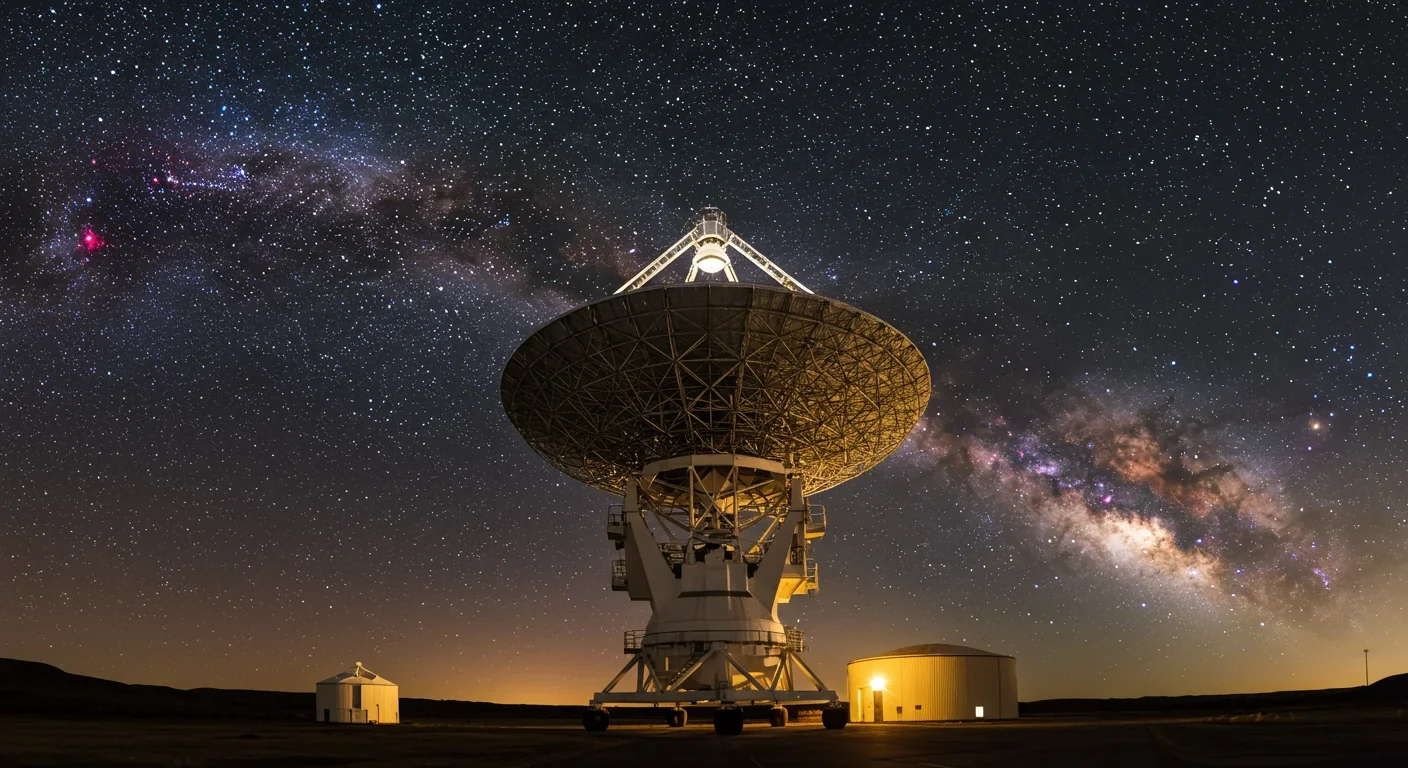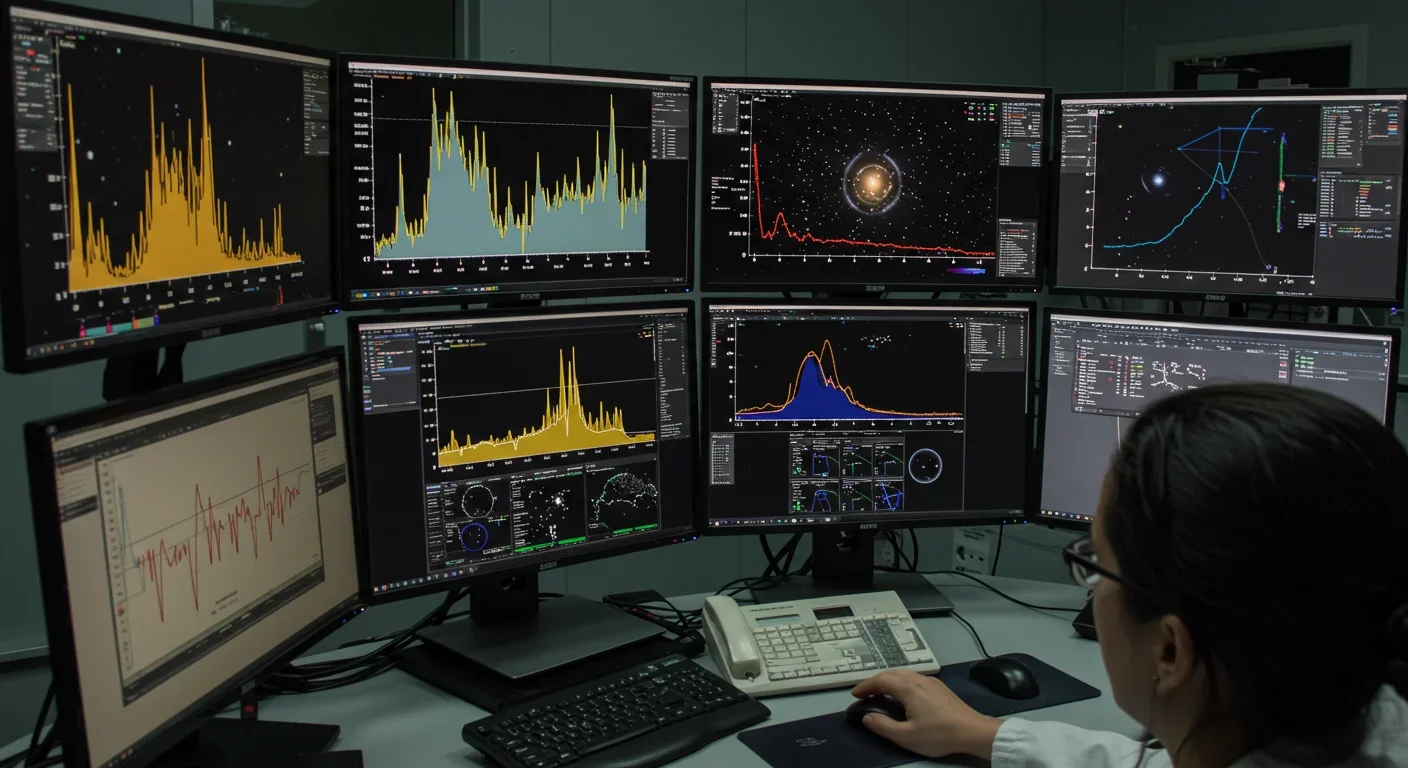Fusion Rockets Could Reach 10% Light Speed: The Breakthrough

TL;DR: Scientists searching for alien Dyson spheres face an unexpected challenge: exotic stellar objects called strange stars could produce nearly identical observational signatures, creating a cosmic shell game between natural phenomena and potential technosignatures.

Picture this: somewhere in the cosmos, an advanced civilization has wrapped their sun in a colossal energy-harvesting shell. We scan the skies searching for this telltale signature, but what if we keep missing it because nature itself created something that looks almost identical? That's the puzzle keeping astronomers up at night, and it's weirder than you think.
The concept of a Dyson sphere started as a quirk of imagination. In 1937, science fiction author Olaf Stapledon described gauze-like light traps surrounding stars in his novel Star Maker. Two decades later, physicist Freeman Dyson took that wild idea and turned it into a legitimate scientific hypothesis.
Here's where it gets interesting: Dyson himself later called his 1960 paper "a little joke" and regretted how people interpreted it. He never meant a solid shell—physics makes that impossible. A rigid sphere around a star would be gravitationally unstable, collapsing the moment any force nudged it off-center. What Dyson actually envisioned was "a loose collection or swarm of objects traveling on independent orbits around the star."
Think of it less like wrapping paper and more like a buzzing cloud of solar panels, each one orbiting independently, collectively capturing a star's energy output. That's the realistic Dyson swarm scientists actually search for today.
The signature? Excess infrared radiation. A Dyson swarm would absorb visible starlight and re-radiate it as heat, making the star appear dimmer in optical wavelengths but brighter in infrared. It's like wearing a black shirt in summer—you absorb sunlight and give off heat.
Now enter strange stars, one of the cosmos's most exotic possibilities. These aren't your garden-variety neutron stars. While regular neutron stars pack atomic nuclei so tightly they touch, strange stars might contain even weirder matter: quarks that have broken free from their nuclear prisons.
Inside a neutron star, gravity crushes matter to densities higher than an atomic nucleus. At some threshold—maybe 2.5 times the density of nuclear matter—protons and neutrons might dissolve entirely. Their constituent quarks (up, down, and strange) could form a soup of free particles, creating what physicists call strange quark matter.
Dr. Victor Doroshenko from Universität Tübingen puts it bluntly: "Neutron stars have yet unknown properties of matter; they have much higher density than atomic nuclei." They're celestial laboratories testing physics we can't replicate on Earth.
The lightest known neutron star, tucked inside the supernova remnant HESS J1731-347, has about half the mass of a typical neutron star. Professor Andrea Santangelo calls it "the most promising quark or strange-matter star candidate we know of so far," even though its properties could still fit a normal neutron star. That ambiguity? That's the whole problem.

Here's where things get deliciously complicated. Strange stars and Dyson swarms could produce remarkably similar observational signatures, and that overlap creates a detection nightmare.
Both scenarios involve objects that absorb and re-radiate energy in unusual ways. A strange star's exotic surface could interact with surrounding material differently than a normal neutron star, potentially creating infrared excesses or unusual light curves. A Dyson swarm does the same thing, but for entirely different reasons.
The challenge is that astrophysics already gives us plenty of ways to mimic these signatures without invoking aliens. Dusty disks around stars, especially young or dying ones, absorb starlight and glow in infrared. So do planetary collisions, asteroid belts, and various stellar wind phenomena.
Take KIC 8462852, better known as Tabby's Star. When citizen scientists spotted its bizarre, irregular dimming in 2015, the internet exploded with Dyson-sphere speculation. Media outlets ran wild with headlines about alien megastructures. Then came the letdown: later analysis showed the dimming was wavelength-dependent, exactly what you'd expect from dust, not what you'd see from a solid structure.
Brian C. Lacki, who studies technosignature detection, frames the core problem: "It is impossible to determine whether the radio emissions from galaxies are natural or artificial based solely on their brightness." The same logic applies to infrared excess. Brightness alone doesn't tell you why something shines.
So how do astronomers actually look for these needle-in-a-haystack anomalies? They cast incredibly wide nets and then sift carefully.
Project Hephaistos represents the state of the art. Researchers analyzed optical and infrared observations from Gaia, 2MASS, and WISE, examining five million sources to identify potential Dyson sphere candidates. Out of millions, they flagged seven objects worth a closer look.
Fermilab's earlier infrared survey found 17 "ambiguous candidates," four of which scientists labeled "amusing but still questionable" back in 2006. That phrasing tells you everything about the challenge: even when you find something weird, you can't be sure what you're seeing.
The search strategy relies on multi-wavelength observations. You don't just look in one color; you build a complete spectrum from radio waves through visible light to infrared and beyond. Each wavelength reveals different information about what's happening.
For strange stars specifically, astronomers use X-ray telescopes. The combination of Gaia distance measurements with X-ray spectra from XMM-Newton and Suzaku allows precise calculation of mass and radius. These parameters push the edge of what neutron star equations of state can explain, hinting at exotic cores.
Breakthrough Listen takes a different approach for technosignatures, monitoring radio emissions from galaxies using Green Bank and Parkes telescopes. The project also watches for optical signals with the Automated Planet Finder. By observing at multiple frequencies simultaneously, researchers can separate natural galactic radio output from potential artificial transmissions.
The statistical method is clever. Since we know roughly how many galaxies exist at each brightness level, we can set upper limits on artificial sources. Lacki's analysis concludes that Type III civilizations—those that broadcast with the luminosity of an entire galaxy—exist in fewer than 1 in 100,000 large galaxies. That's a hard constraint based on what we don't see.

The intersection of strange-star physics and SETI creates fascinating theoretical territory. Both fields push the boundaries of known physics, and both deal with phenomena we've never definitively observed.
Hyperon-rich neutron stars, for instance, can contain up to 39% exotic particles in their cores while still matching observed masses. The threshold density for hyperon appearance triggers a pronounced drop in the speed of sound within the star—a distinct signature potentially observable through gravitational wave signals or pulsar timing.
These non-monotonic behaviors in dense matter could, in principle, produce observational quirks that mimic technological artifacts. A strange star interacting with a debris disk might create modulated infrared signatures that look engineered but are purely natural.
Meanwhile, the nanotechnology needed to build an actual Dyson swarm is rapidly advancing. The global nanotechnology market is projected to grow from $6.59 billion in 2024 to $115.41 billion by 2034. NASA's ARMADAS system demonstrated autonomous assembly by building a 256-voxel shelter structure in just 4.2 days using "self-reprogrammable mechanical metamaterials."
Self-replicating nanorobots could transform Dyson swarm construction from a centuries-long project into a matter of decades. With exponential manufacturing capabilities and in-situ resource utilization—harvesting asteroids and comets for raw materials—the engineering barriers are falling.
So we're in this odd position: the physics of building megastructures is becoming clearer just as we're discovering natural phenomena that could imitate them.
How do you reliably distinguish infrared excess from a dusty disk versus that from a Dyson swarm? Right now, you can't. Not with certainty.
The most promising approach involves looking for combinations of anomalies that don't fit natural explanations. A star that's too dim in optical light, too bright in infrared, with light curves that show non-periodic dips, located in a spectral region where dust shouldn't exist—that starts to become interesting.
Time-domain astronomy helps. Tabby's Star taught us that watching how brightness changes over months and years reveals information you miss in single snapshots. Dust clouds evolve and dissipate in predictable ways. A megastructure under construction might show different patterns.
Spectroscopy is crucial. The exact wavelengths of absorbed and emitted light tell you about temperature, composition, and geometry. A uniform shell would produce different spectral features than a clumpy disk. Strange matter interacting with normal matter should leave chemical fingerprints in emission lines.
Lacki emphasizes using "as many frequencies as possible to separate natural AGN signatures from potential artificial transmissions." Deep, wide surveys across the electromagnetic spectrum maximize the chance of catching isolated technosignatures embedded in otherwise normal emission.
The Dyson sphere has evolved from speculative megastructure to legitimate search target, but the journey has been humbling. Every candidate so far has turned out to have a prosaic explanation.
That doesn't mean the search is futile. It means we're learning to ask better questions and design smarter filters. Each false positive teaches us something about astrophysics we didn't know before.
The collective bound method used for radio-bright galaxies provides a statistical framework that works for infrared searches too. Instead of claiming individual detections, scientists set population-level constraints: "If Dyson swarms exist, no more than X% of galaxies can host them, based on what we observe."
This probabilistic approach shifts SETI from "we found aliens!" to "we can rule out certain scenarios about galactic colonization." It's less exciting for headlines but more scientifically rigorous.
Strange stars complicate this picture by expanding the parameter space of what natural objects can do. Before we discovered hyperonic matter and strange quarks, we had a narrower envelope of "normal neutron star behavior." Now that envelope is wider, which means some phenomena we might have called anomalous five years ago could be explained by exotic but natural physics.
Future telescopes will dramatically improve our ability to distinguish natural from artificial signatures. The James Webb Space Telescope's infrared sensitivity can characterize exoplanet atmospheres; that same capability could scrutinize candidate Dyson structures in unprecedented detail.
Next-generation gravitational wave detectors will probe the interiors of neutron stars through pulsar timing and merger signals. If strange matter exists, we'll see it in the mass-radius relationships and tidal deformability of compact objects.
The Square Kilometre Array, once operational, will provide radio observations orders of magnitude more sensitive than current instruments. Subtle frequency patterns that current telescopes can't resolve might become obvious.
Machine learning is already transforming the search. Training algorithms on known astrophysical phenomena lets them flag outliers humans might miss in catalogs of millions of objects. But the same tools can also teach us which "outliers" are just rare natural events we haven't properly cataloged.
The critical insight is that searching for Dyson spheres and studying strange stars aren't separate endeavors. Both push our understanding of extreme physics. Both require distinguishing subtle signals from overwhelming backgrounds. Both force us to confront what we don't know about how the universe works.
Freeman Dyson originally proposed his swarm concept as a way to think about the long-term future of technological civilizations. It was a thought experiment about energy and entropy, not a prediction. He'd probably be amused that sixty-five years later, we're building actual survey programs to hunt for the thing he jokingly suggested.
Meanwhile, strange stars were once considered too exotic to bother with. Now we have candidate observations and ab initio calculations predicting their properties. HESS J1731-347 might be the first confirmed strange star, or it might be a perfectly ordinary low-mass neutron star. The data fits both interpretations.
That ambiguity is where the frontier lives. We're at a stage where our instruments can almost tell the difference between extraordinary possibilities, but not quite. The next generation of observations will either confirm exotic scenarios or rule them out definitively.
Either outcome advances our understanding. If we find a Dyson swarm, the universe just got a lot more interesting. If we confirm strange stars, we've discovered a new state of matter that exists nowhere else in nature. If we find neither, we've still mapped the parameter space of what's possible and impossible in astrophysics.
The search for alien megastructures has become a search for the boundaries of natural law. Strange stars might hide Dyson spheres, or they might just be strange stars. But the only way to know is to keep looking at the sky and asking better questions about what we see.
The universe has fooled us before. It'll fool us again. But every time we catch it in the act, we learn something new about how reality actually works. And that's worth the occasional false alarm about aliens.

Recent breakthroughs in fusion technology—including 351,000-gauss magnetic fields, AI-driven plasma diagnostics, and net energy gain at the National Ignition Facility—are transforming fusion propulsion from science fiction to engineering frontier. Scientists now have a realistic pathway to accelerate spacecraft to 10% of light speed, enabling a 43-year journey to Alpha Centauri. While challenges remain in miniaturization, neutron management, and sustained operation, the physics barriers have ...

Epigenetic clocks measure DNA methylation patterns to calculate biological age, which predicts disease risk up to 30 years before symptoms appear. Landmark studies show that accelerated epigenetic aging forecasts cardiovascular disease, diabetes, and neurodegeneration with remarkable accuracy. Lifestyle interventions—Mediterranean diet, structured exercise, quality sleep, stress management—can measurably reverse biological aging, reducing epigenetic age by 1-2 years within months. Commercial ...

Data centers consumed 415 terawatt-hours of electricity in 2024 and will nearly double that by 2030, driven by AI's insatiable energy appetite. Despite tech giants' renewable pledges, actual emissions are up to 662% higher than reported due to accounting loopholes. A digital pollution tax—similar to Europe's carbon border tariff—could finally force the industry to invest in efficiency technologies like liquid cooling, waste heat recovery, and time-matched renewable power, transforming volunta...

Humans are hardwired to see invisible agents—gods, ghosts, conspiracies—thanks to the Hyperactive Agency Detection Device (HADD), an evolutionary survival mechanism that favored false alarms over fatal misses. This cognitive bias, rooted in brain regions like the temporoparietal junction and medial prefrontal cortex, generates religious beliefs, animistic worldviews, and conspiracy theories across all cultures. Understanding HADD doesn't eliminate belief, but it helps us recognize when our pa...

The bombardier beetle has perfected a chemical defense system that human engineers are still trying to replicate: a two-chamber micro-combustion engine that mixes hydroquinone and hydrogen peroxide to create explosive 100°C sprays at up to 500 pulses per second, aimed with 270-degree precision. This tiny insect's biochemical marvel is inspiring revolutionary technologies in aerospace propulsion, pharmaceutical delivery, and fire suppression. By 2030, beetle-inspired systems could position sat...

The U.S. faces a catastrophic care worker shortage driven by poverty-level wages, overwhelming burnout, and systemic undervaluation. With 99% of nursing homes hiring and 9.7 million openings projected by 2034, the crisis threatens patient safety, family stability, and economic productivity. Evidence-based solutions—wage reforms, streamlined training, technology integration, and policy enforcement—exist and work, but require sustained political will and cultural recognition that caregiving is ...

Every major AI model was trained on copyrighted text scraped without permission, triggering billion-dollar lawsuits and forcing a reckoning between innovation and creator rights. The future depends on finding balance between transformative AI development and fair compensation for the people whose work fuels it.